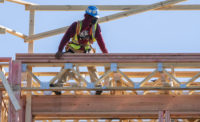Management
Why M.C. Dean Chose and Stuck With 'New View' Safety


John Bennett
John Bennett is senior vice president of safety of electrical engineer and systems integrator M.C. Dean, which began using the 'New View' safety approach in 2010. That year the company started deliberately shifting its occupational health and safety efforts toward what it describes as a people and process-focused approach and away from a rules and compliance system. Bennett says M.C. Dean's philosophy is to understand from its employees why errors are made, and then design work processes so the company is prepared for potential failures and can mitigate serious harm as much as possible. He recently answered questions from ENR Deputy Editor Richard Korman.
What first triggered your interest in 'New View' safety?
The 1981 Business Roundtable reports on construction efficiency, the 1982 book Loss Control Management by Frank Bird and the approach by [contractor] Kiewit to safety, which is management-driven, were some things that triggered my interest in 'New View' safety.
Were there any challenges shifting from a rules and compliance focus to people and processes?
Yes, it all begins with changing the culture of the organization. The culture needed to shift from a compliance, discipline and enforcement approach to a more people and process-focused approach. People-in-mind, our program, is about engaging the workforce in the operational risk management process.
With an increased emphasis on organizational culture, systems and technical solutions, we implemented processes that engage our workforce. They help us to define, predict and forecast potentially fatal work activities. These improvements have significantly reduced incidents, reflecting a long-term decrease in cost and injuries. We expect this trend to continue as we rely on actionable feedback from an empowered workforce.
Is there any way to combine behavioral safety with 'New View' safety, or are they incompatible?
From my perspective, behavioral safety is not compatible with the people-in-mind approach we use. Only an engaging and collaborative team can help solve workplace issues.
What do owners and clients think? Do they get it?
Owners who understand frequently ask us to help implement the people-in-mind philosophy versus a top-down regulatory approach. They understand that the 1970s compliance approach creates a fear-based culture where safety staff lead the charge and discipline people for the wrong reason.
Do owners always prefer to talk in terms of TRIR [Total Recordable Incident Rate] and other injury stats?
Our management doesn’t focus on compliance; rather, our workforce does. The team works on continuous improvement of our operational risk management process, the hierarchy of controls and potentially fatal work activities and the connection to high energy sources [that pose the greatest hazards].
A key element of the process is development of the project risk assessment in which every definable feature of the work has its risk assessed and forecasted on the schedule. The team is then prepared to execute the work with a broad understanding of associated risks. Our people-in-mind approach factors in the external standards, such as ANSIZ10, which is a U.S. Standard for Occupational Health and Safety Management Systems and ISO 45001, the International Standard for OHSMS and the ISO 45003 Standard for Psychological Safety. The approach philosophy and mechanisms have worked effectively over the years.
Many owners, general contractors and specialty contractors are currently using this approach.TRIR and other measurements of failure do not advance the process of problem solving. The teams solve problems before the work begins.
But so far I’ve seen only a handful of contractors using 'New View' safety or saying publicly that they do.
The construction industry is at a critical turning point. Organizations that fail to recognize the advantage of a fully engaged team with a vision for the future will fade away.




